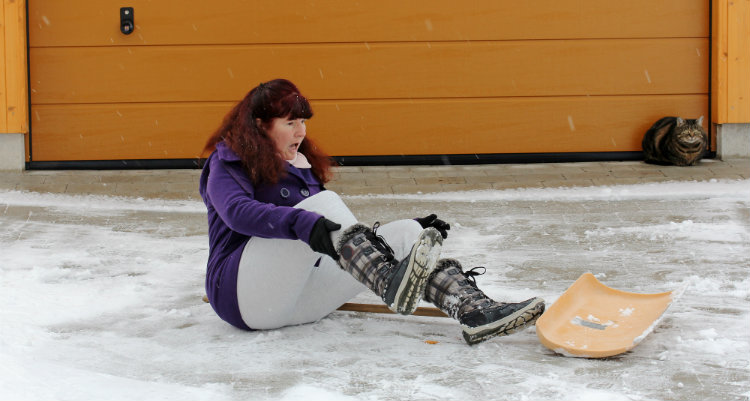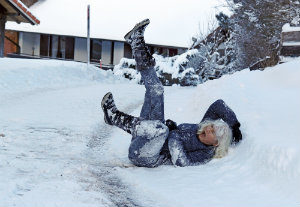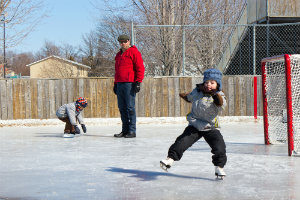Avoiding Common Winter Injuries

Winter is here. Time to enjoy the season and keep those winter injuries to a minimum. The more you know, the better prepared you will be. The most common winter accidents that can lead to severe injuries include:
- Slips and falls on ice
- Muscle strains from shoveling snow
- Accidents while playing winter sports
Slips and Falls on ice

Slip and fall on snow and ice.
Ice is difficult to see whether day or night. Severe injuries, such as wrenching your back, can occur as you twist to regain your balance and avoid falling. Other types of common injuries include:
- Bruises
- Head or traumatic brain injuries/concussions
- Ankle strains or other kinds of muscle/ligament sprains
- Broken bones, most commonly hip and wrist fractures
- Back injuries
- Injuries to the spinal cord
If you had a slip and fall accident while on someone else’s property, you may have a premises liability case. Premises liability holds property owners legally responsible for accidents that occur on their property due to unsafe conditions.
Need more information?
Safety Tips on Slippery and Icy Surfaces
- Wear proper footwear. Make sure you have good treads to give you good traction – waffled, ridged or heavily textured soles. You also want shoes that are well-insulated and waterproof.
- Keep a pair of rubber over-shoes that fit over street shoes handy – at work, in your car.
- Always take your time when walking on slippery, icy and snowy surfaces. Do the “penguin shuffle” and take short steps.
- Avoid wet leaves, icy patches and snowbanks.
- Use salt and sand or ice melt on your driveway and stairs outside your home.
- Watch out for black ice.
- When entering a building, watch for slippery floors and stomp off as much snow and water as possible so as not to create wet, slippery conditions inside.
- Where possible, use handrails to prevent falls.
Shoveling Snow
Shoveling snow takes a lot of physical exertion working in low temperatures. In fact, it is one of the most strenuous activities you can do. As you scoop, lift and toss the snow, you put a lot of stress and strain on your body because it requires twisting and lifting repetitive actions.
A national study found that over the course of eleven years, there was an average of 11,500 emergency room visits due to snow shoveling injuries.
The most common injuries from shoveling snow are soft tissue injuries to the lower back region.
Take it easy and slow. Use the right shovel and the correct form.
- Purchase the right shovel for the job. Plastic shovels are lightweight and do not add to the weight of the snow. Steel shovels are the heaviest and require the most energy to use.
- Shove snow to the side on sidewalks and driveways. Snow shovels designed to push rather than scoop require less physical exertion.
- Ergonomic shovels are designed to lessen the strain on your lower back while scooping snow.
Use the correct form when shoveling – back is straight, not curved; knees bent, not straight, and always bend over from the hip.
- Frequent trips outside to clear snow will be easier on your body and lessen your chance of shoveling injuries.
Winter Sports
Winter leads to fun and more extreme sports in the snow — ice hockey, ice skating, skiing, snowboarding, sledding, toboganning. These sports can lead to falls and collisions causing injuries such as broken bones, stiff muscles and joints.
Avoid Sports-Related Injuries

Winter sport – ice skating.
Kids love winter sports, but there are risks that come with them. Sliding headfirst down a hill leaves your child open to hitting his or her head or getting hit by a car if near a roadway.
- Wear proper protective gear for the sport – goggles, helmets, gloves, padding.
- Wear appropriate footwear. Shoes that provide warmth. dryness and good traction.
- Learn how to fall safely for the sport you are participating in, such as skiing. Take lessons when needed.
- Wrist guards can lessen the impact of a fall. Same with good ankle support.
- Be sure children have the proper adult supervision.
Common Types of Winter Injuries
- Head, shoulder, neck, back injuries
- Knee joint pain
- Wrist sprains
- Elbow fractures, dislocations
- Ankle sprains and strains
- Hip fractures
- Broken bones from slippery snow
- Painful bruises from icy conditions
- Muscle strains from shoveling
- Ruptured discs from heavy lifting
- Torn ACLs from winter sports
- Concussions from sledding
Seriously Injured in a Slip & Fall Accident?
Have you been seriously injured in a slip and fall accident? We have a successful track record of helping accident victims collect the compensation they deserve. Call Nash & Franciskato today at (877) 284-6600. One of our experienced staff will speak with you personally and we will provide you with a free, no-obligation case evaluation.
CONTACT US FOR A FREE REVIEW OF YOUR CASE
JUST WANT TO STAY UP-TO-DATE?
SIGN UP FOR OUR EMAIL NEWSLETTER
If you would like to receive news and blog updates on a regular basis, sign up to receive our email newsletter. Your email address will only be used to send you our newsletter and respond to inquiries.
SIGN UP FOR NEWSLETTER
Past results afford no guarantee of future results and each case is different and is judged on its own merits. The choice of a lawyer is an important decision and should not be based solely upon advertisements.
Editor’s Note: This post was originally published November 18, 2019. It was reviewed on November 14, 2022 and again on December 19, 2023 and updated for content and accuracy.
Related


